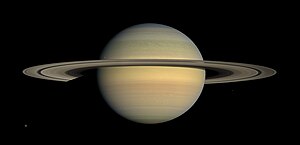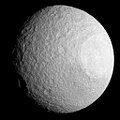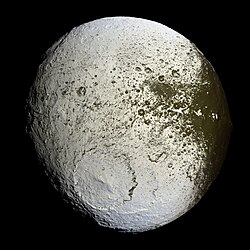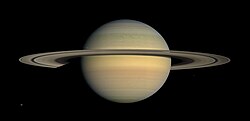Cassini (sonda)
| Cassini | ||||||
|---|---|---|---|---|---|---|
 | ||||||
| Pojmenováno po | Giovanni Domenico Cassini a Christiaan Huygens | |||||
| COSPAR | 1997-061A | |||||
| Katalogové číslo | 25008 | |||||
| Start | 15. října 1997 | |||||
| Kosmodrom | Eastern Test Range | |||||
| Nosná raketa | Titan 4B Centaur | |||||
| Stav objektu | konec mise 15. září 2017 - shoření v atmosféře Saturnu | |||||
| Provozovatel | USA, NASA – JPL | |||||
| Výrobce | USA, NASA – JPL | |||||
| Druh | planetární sonda | |||||
| Dceřiné těleso | Huygens | |||||
| Hmotnost | vzletová 5712 kg prázdná 2523 kg | |||||
| Parametry dráhy | ||||||
| ||||||
| Oficiální web | Oficiální web | |||||
| Některá data mohou pocházet z datové položky. | ||||||
Cassini byla americká planetární sonda, která byla jako první navedena na orbitu Saturnu pro jeho průzkum, jeho prstenců a systému jeho měsíců. Vypuštěna byla v roce 1997 a po dvacetileté výzkumné misi, v roce 2017, plánovaně shořela v atmosféře Saturnu.[1] Na jejím přístrojovém vybavení se podílely také evropská organizace pro výzkum vesmíru ESA a italská národní kosmická agentura ASI. Sonda měla dvě samostatné části: mateřskou sondu Cassini (pojmenovanou po italském astronomovi Giovanni Domenico Cassinim) a atmosférickou sondu Huygens (pojmenovanou po nizozemském vědci Christiaanu Huygensovi).
Středisko NASA v Pasadeně bylo pověřeno pozemním sledováním rádiového signálu vysílaného sondou jednak ke studiu vysoké atmosféry a ionosféry planety, jednak ke zjišťování vlastností gravitačního pole Saturnu a jeho jednotlivých měsíců.
Modul Huygens, určený k průzkumu měsíce Titan, dosáhl prvního přistání dosaženého ve vnější sluneční soustavě. Jezera z kapalného methanu zpozorované sondou na Titanu, jsou jediná známá jezera mimo planetu Zemi. Sonda Cassini také zjistila, že ledový Saturnův měsíc Enceladus skrývá podpovrchový, slaný oceán pod svou kůrou.
Přístrojové vybavení

Sonda Cassini nesla soubor vědeckých přístrojů, který tvoří:
- kamerový systém se dvěma CCD kamerami;
- ultrafialový zobrazující spektrograf;
- mapující spektrograf pro viditelnou a infračervenou oblast;
- kombinovaný infračervený spektrometr;
- radiolokátor a radarový výškoměr;
- analyzátor kosmického prachu;
- plazmový spektrometr;
- hmotnostní spektrometr;
- magnetometr;
- magnetosférické zobrazovací zařízení;
- soubor přístrojů pro studium vlastností plazmatu.
Průběh letu

První plánované datum startu bylo 6. října 1997, to se ale nezdařilo dodržet pro poruchu klimatizačního zařízení na modulu Huygens. Následné poškození ochranné fólie pouzdra způsobilo týdenní odklad. Další plánované datum startu bylo 13. října, ale tentokrát startu zabránilo nepříznivé počasí na mysu Canaveral.
Po startu 15. října 1997 z kosmodromu na mysu Canaveral na Floridě (USA) bylo vzhledem k značné hmotnosti sondy během letu k Saturnu využito gravitačních manévrů při dvou průletech kolem Venuše (26. dubna 1998 ve výši 234 km a 24. června 1999 ve výši 600 km), kolem Země (18. srpna 1999 ve výši 1171 km) a kolem Jupiteru (30. prosince 2000 ve výši přibližně 10 mil. km). Každý z těchto gravitačních manévrů sondu urychlil, čímž se podstatně zkrátila doba přeletu k Saturnu. Průletů kolem Venuše a Země bylo využito ke kalibraci vědeckých přístrojů, v oblasti planety Jupiter sonda prováděla v omezeném rozsahu vědecká měření.
Na orbitě Saturnu
Do Saturnovy sféry gravitačního vlivu vstoupila sonda 9. března 2004. Zážehem hlavního korekčního motoru na dobu 96 minut byla 1. července 2004 sonda navedena na oběžnou dráhu kolem planety. Dne 25. prosince 2004 se od sondy Cassini oddělila sonda Huygens, která 14. ledna 2005 úspěšně přistála na měsíci Titan. Během jejího přistávání sloužila sonda Cassini jako retranslační stanice pro předávání vědeckých a technických dat ze sondy Huygens na Zemi.

Sonda Huygens přistála na měsíci Titanu 14. ledna 2005 a během sestupu atmosférou a po přistání shromáždila značné množství vědeckých poznatků o tomto tělese. Pravděpodobně na povrchu měsíce vydržela pracovat 4 hodiny, avšak Cassini, zprostředkovávající informace, se po dvou hodinách dostala do zákrytu měsíce, přenos byl tedy přerušen.
Sonda provedla výzkum měsíců Saturnu. V prosinci 2007 odeslala sonda na Zem fotografie svědčící o existenci tekutých uhlovodíků na měsíci Titan. V tu dobu jej minula po čtyřicáté.

Konec mise byl původně plánován na 30. června 2008, 15. dubna 2008 však NASA oznámila prodloužení mise nejméně o dva roky.[2] V roce 2014 došlo k dalšímu prodloužení mise sondy.[3]
V letech 2010 až 2012 sonda proletěla třikrát poblíž měsíce Enceladus u Saturnu. Na jaře 2014 byly oznámeny výsledky přijatých dat, svědčící o velkém množství slané vody pod povrchem měsíce.[4][5]
Na podzim 2013 NASA oznámila příjem signálů ze sondy, pocházejících z měření infračerveným spektrometrem u měsíce Titan, dosvědčujícím existenci molekul propanu či propylenu.[6][7]
Sonda Cassini byla plánovaně zničena ponořením do atmosféry Saturnu 15. září 2017, kdy vyslala poslední sérii fotek.[8]
Snímky největších měsíců Saturnu vyfocené sondou Cassini
Původ jména
Sonda byla pojmenována na počest italsko-francouzského astronoma G. D. Cassiniho (1625–1712), který se nebývalou měrou zasloužil o výzkum Saturnu a objevil čtyři jeho měsíce.
Odkazy
Reference
- ↑ Sonda Cassini po 20 letech služby shořela v atmosféře Saturnu. iDNES.cz [online]. 2017-09-15. Dostupné online.
- ↑ BROWN, Dwayne; MARTINEZ, Carolina. NASA Extends Cassini's Grand Tour of Saturn. Cassini-Huygens, Mission to Saturn & Titan [online]. 2008-04-15 [cit. 2008-04-17]. Dostupné v archivu pořízeném dne 2008-04-20.
- ↑ LEONE, Dan. Curiosity, Cassini Among 7 Extended Planetary Missions [online]. Spacenews.com [cit. 2014-09-01]. Dostupné v archivu. (anglicky)
- ↑ mik, Novinky. Tekutý slaný oceán pod povrchem Saturnova měsíce má hloubku 10 kilometrů. Novinky.cz [online]. Borgis, 2014-04-15 [cit. 2014-04-15]. Dostupné online.
- ↑ ČADEK, Ondřej. Geofyzici z MFF objasňují aktivitu gejzírů na Enceladu [online]. Matfyz.cz, 2015-07-14 [cit. 2014-07-14]. Dostupné online.
- ↑ Novinky. Sonda Cassini na měsíci Titanu objevila stopy plastu. Novinky.cz [online]. Borgis, 2013-10-02 [cit. 2013-10-04]. Dostupné online.
- ↑ NASA's Cassini Spacecraft Finds Ingredient of Household Plastic in Space [online]. NASA JPL, 2013-09-30 [cit. 2024-04-25]. Dostupné online. (anglicky)
- ↑ Here's How and When NASA Will Finally Destroy Cassini. ScienceAlert [online]. 2017-04-08. Dostupné online.
Související články
Externí odkazy
 Obrázky, zvuky či videa k tématu Sonda Cassini na Wikimedia Commons
Obrázky, zvuky či videa k tématu Sonda Cassini na Wikimedia Commons - Cassini-Huygens Home Page (anglicky)
- Encyklopedie SPACE 40 - Cassini (česky)
- Home Page ESA (anglicky)
- Cassini-Huygens Home Page JPL (anglicky)
- Encyklopedie SPACE 40 - Cassini (česky)
- Encyklopedie SPACE 40 - Huygens (česky)
- Jezero na Titanu (česky)
Média použitá na této stránce
Iapetus as seen by the Cassini probe.
Original NASA caption: Cassini captures the first high-resolution glimpse of the bright trailing hemisphere of Saturn's moon Iapetus.
This false-color mosaic shows the entire hemisphere of Iapetus (1,468 kilometers, or 912 miles across) visible from Cassini on the outbound leg of its encounter with the two-toned moon in Sept. 2007. The central longitude of the trailing hemisphere is 24 degrees to the left of the mosaic's center.
Also shown here is the complicated transition region between the dark leading and bright trailing hemispheres. This region, visible along the right side of the image, was observed in many of the images acquired by Cassini near closest approach during the encounter.
Revealed here for the first time in detail are the geologic structures that mark the trailing hemisphere. The region appears heavily cratered, particularly in the north and south polar regions. Near the top of the mosaic, numerous impact features visible in NASA Voyager 2 spacecraft images (acquired in 1981) are visible, including the craters Ogier and Charlemagne.
The most prominent topographic feature in this view, in the bottom half of the mosaic, is a 450-kilometer (280-mile) wide impact basin, one of at least nine such large basins on Iapetus. In fact, the basin overlaps an older, similar-sized impact basin to its southeast.
In many places, the dark material--thought to be composed of nitrogen-bearing organic compounds called cyanides, hydrated minerals and other carbonaceous minerals--appears to coat equator-facing slopes and crater floors. The distribution of this material and variations in the color of the bright material across the trailing hemisphere will be crucial clues to understanding the origin of Iapetus' peculiar bright-dark dual personality.
The view was acquired with the Cassini spacecraft narrow-angle camera on Sept. 10, 2007, at a distance of about 73,000 kilometers (45,000 miles) from Iapetus.
The color seen in this view represents an expansion of the wavelengths of the electromagnetic spectrum visible to human eyes. The intense reddish-brown hue of the dark material is far less pronounced in true color images. The use of enhanced color makes the reddish character of the dark material more visible than it would be to the naked eye.
This mosaic consists of 60 images covering 15 footprints across the surface of Iapetus. The view is an orthographic projection centered on 10.8 degrees south latitude, 246.5 degrees west longitude and has a resolution of 426 meters (0.26 miles) per pixel. An orthographic view is most like the view seen by a distant observer looking through a telescope.
At each footprint, a full resolution clear filter image was combined with half-resolution images taken with infrared, green and ultraviolet spectral filters (centered at 752, 568 and 338 nanometers, respectively) to create this full-resolution false color mosaic.
Saturn's north polar hexagon basks in the Sun's light now that spring has come to the northern hemisphere. Many smaller storms dot the north polar region and Saturn's signature rings, which appear to disappear on account of Saturn's shadow, put in an appearance in the background.
The image was taken with the Cassini spacecraft's wide-angle camera on Nov. 27, 2012 using a spectral filter sensitive to wavelengths of near-infrared light centered at 750 nanometers.
The view was acquired at a distance of approximately 403,000 miles (649,000 kilometers) from Saturn and at a Sun-Saturn-spacecraft, or phase, angle of 21 degrees. Image scale is 22 miles (35 kilometers) per pixel.Titan's atmosphere makes Saturn's largest moon look like a fuzzy orange ball in this natural color view from the Cassini spacecraft.
Titan's north polar hood is visible at the top of the image, and a faint blue haze also can be detected above the south pole at the bottom of this view.
This view looks toward the anti-Saturn side of Titan (3,200 miles, or 5,150 kilometers across). North is up. Images taken using red, green and blue spectral filters were combined to create this natural color view. The images were obtained with the Cassini spacecraft wide-angle camera on Jan. 30, 2012 at a distance of approximately 119,000 miles (191,000 kilometers) from Titan. Image scale is 7 miles (11 kilometers) per pixel.This natural color view of the planet Saturn was created from images collected shortly after Cassini began its extended Equinox Mission in July 2008. (Saturn actually reached equinox on August 11, 2009.)
Dione with Saturn and its rings.
- "Images taken on Oct. 11, 2005, with blue, green and infrared (centered at 752 nanometers) spectral filters were used to create this color view, which approximates the scene as it would appear to the human eye. The images were obtained with the Cassini spacecraft wide-angle camera at a distance of approximately 39,000 kilometers (24,200 miles) from Dione and at a Sun-Dione-spacecraft, or phase, angle of 22 degrees. The image scale is about 2 kilometers (1 mile) per pixel."
Flight mechanics from NASA’s Jet Propulsion Laboratory (JPL) in Pasadena, Calif., lower the Cassini spacecraft onto its launch vehicle adapter in KSC’s Payload Hazardous Servicing Facility. The adapter will later be mated to a Titan IV/Centaur expendable launch vehicle that will lift Cassini into space. Scheduled for launch in October, the Cassini mission, a joint US-European four-year orbital surveillance of Saturn's atmosphere and magnetosphere, its rings, and its moons, seeks insight into the origins and evolution of the early solar system. It will take seven years for the spacecraft to reach Saturn. JPL is managing the Cassini project for NASA
PIA18317: Tethys the Target
http://photojournal.jpl.nasa.gov/catalog/PIA18317
Like most moons in the Solar System, Tethys is covered by impact craters. Some craters bear witness to incredibly violent events, such as the crater Odysseus (seen here at the right of the image).
While Tethys is 1,062 kilometers (660 miles) across, the crater Odysseus is 450 kilometers (280 miles) across, covering about 18 percent of the moon's surface area. A comparably sized crater on Earth would be as large as Africa!
This view looks toward the anti-Saturn hemisphere of Tethys. North on Tethys is up and rotated 42 degrees to the right. The image was taken in visible light with the Cassini spacecraft narrow-angle camera on April 11, 2015.
The view was acquired at a distance of approximately 190,000 kilometers (118,000 miles) from Tethys. Image scale is 1 kilometer (3,280 feet) per pixel.
The Cassini mission is a cooperative project of NASA, ESA (the European Space Agency) and the Italian Space Agency. The Jet Propulsion Laboratory, a division of the California Institute of Technology in Pasadena, manages the mission for NASA's Science Mission Directorate, Washington. The Cassini orbiter and its two onboard cameras were designed, developed and assembled at JPL. The imaging operations center is based at the Space Science Institute in Boulder, Colorado.
For more information about the Cassini–Huygens mission visit http://saturn.jpl.nasa.gov and http://www.nasa.gov/cassini. The Cassini imaging team homepage is at http://ciclops.org.Cassini color image of Rhea, showing the wispy trailing hemisphere.
Original caption: NASA's Cassini spacecraft captured this view as it neared icy Enceladus for its closest-ever dive past the moon's active south polar region. The view shows heavily cratered northern latitudes at top, transitioning to fractured, wrinkled terrain in the middle and southern latitudes. The wavy boundary of the moon's active south polar region -- Cassini's destination for this flyby -- is visible at bottom, where it disappears into wintry darkness.
This view looks towards the Saturn-facing side of Enceladus. North on Enceladus is up and rotated 23 degrees to the right. The image was taken in visible light with the Cassini spacecraft narrow-angle camera on Oct. 28, 2015.
The view was acquired at a distance of approximately 60,000 miles (96,000 kilometers) from Enceladus and at a Sun-Enceladus-spacecraft, or phase, angle of 45 degrees. Image scale is 1,896 feet (578 meters) per pixel.Original Caption Released with Image: This is an artists concept of Cassini during the Saturn Orbit Insertion (SOI) maneuver, just after the main engine has begun firing. The spacecraft is moving out of the plane of the page and to the right (firing to reduce its spacecraft velocity with respect to Saturn) and has just crossed the ring plane. The SOI maneuver, which is approximately 90 minutes long, will allow Cassini to be captured by Saturn's gravity into a five-month orbit. Cassini's close proximity to the planet after the maneuver offers a unique opportunity to observe Saturn and its rings at extremely high resolution.
















